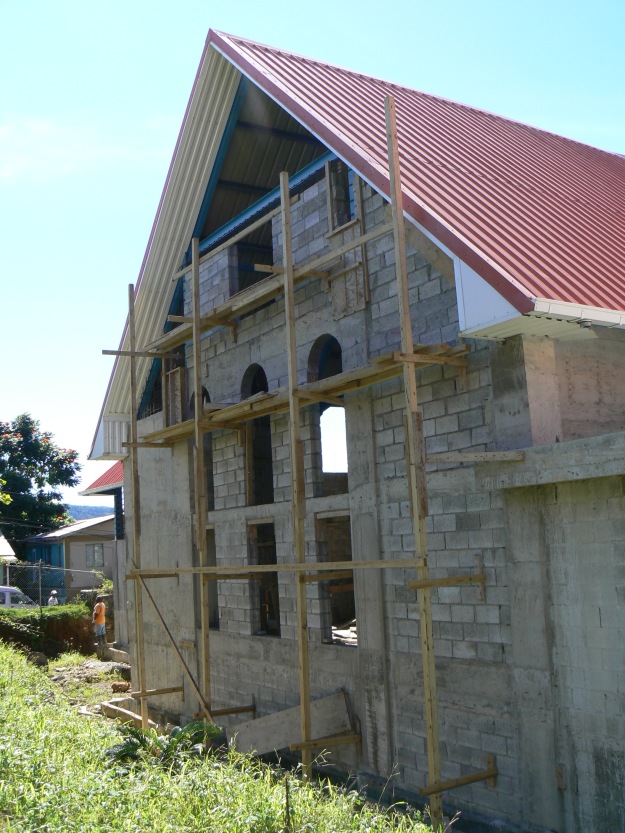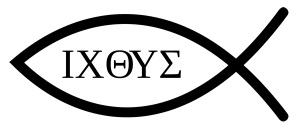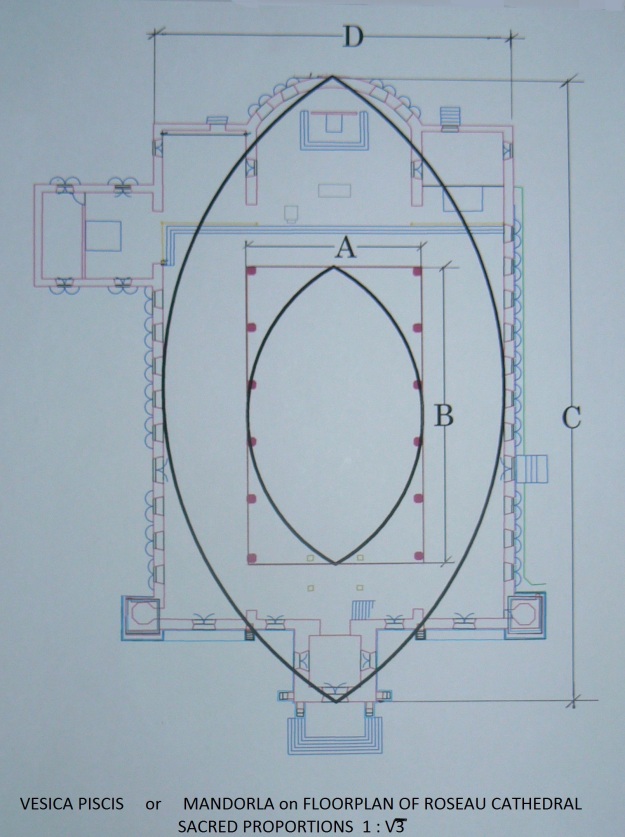Monthly Archives: November 2014
FIRST ROOF TRUSSES installed on the Roseau Cathedral
REV. FR. GEORGE PADDINGTON, the first black priest in Dominica anno 1850
Fr. George Paddington, the first black priest in Dominica
Part 2 by Bernard Lauwyck
The St. Peter’s church in Colihaut: the location of Fr. Paddington burial
A few weeks ago I promised to let you know more about the first black priest in Dominica, Rev. Fr. George or Georges PADDINGTON.
I did not get back to you earlier as I was waiting for a book named “STAMPED WITH THE IMAGE OF GOD, African Americans as God’s Image in Black” which I hoped would provide me with additional information . Was I disappointed with the paucity of information on him, when I received this otherwise very interesting book !
The authors describe Fr. Paddington as “ a very important historical figure in black Catholic history ” as “one of the first priests of African descent outside Africa”.
They got access to his letters written in 1836 from Haiti to the Blessed Pierre Toussaint, an ex-slave in New York, who will be recognized as a black saint soon. These letters are stored on a microfilm in the New York Public Library. An interesting bit of information is that Fr. George came from an acrobat family in Ireland. Arthur Jones the author of “PIERRE TOUSSAINT, A BIOGRAPHY” refers several times to Fr. Paddington’s letters. He claims that these letters are extremely important for historians of black Catholicism.
While I waited on the above mentioned book, I continued my research in French and English documents as I realised that I was breaking new ground with my own research on this black priest buried in Colihaut .
What did I find out from different sources ?
In 1836 Paddington wrote his letters from Haiti to Pierre Toussaint . He had gone to Haiti as an Irish seminarian and his command of French, a language he needed to minister in Haiti, was weak. He received both the minor and the major orders, and was ordained on 21 May 1836 in Port-au-Prince by an US Bishop named John England of the Diocese of Charleston, South Carolina. Most Rev. England, who at the time was Apostolic Delegate of Haiti, was originally from the same Irish Diocese as Paddington, which might have played a role in the selection of Fr. Paddington .
Around 1839, George Paddington wrote that he was planning to go and finish his studies in Rome and France .
Fr. Paddington is several times mentioned in “L’HISTOIRE RELIGIEUSE D’HAITI” , “LES MISSIONS CATHOLIQUES FRANÇAISES AU XIXE SIÈCLE/ MISSIONS D’AMÉRIQUE” and “HISTOIRE D’HAÏTI, VOL. 8”.
In April 1843 Fr. Georges can be placed at “the College de la Propagande”, an international seminary in Rome, where he met Abbé Tisserand, a man who was determined to bring the gospel to the descendents of African slaves.
Fr. Paddington returned to Haiti with Abbé Tisserand . “Abbé Georges Paddington, du diocèse de Kerry, en Irlande ” left Le Havre in France on the 3rd of February 1845 for Haiti on an oceanliner. They arrived at Jacmel in Haiti on the first of March 1845.
“A few excellent Priests, for the greater part members of the Congregation of the Sacred Heart of Mary, instituted for the conversion of the negroes, were sent to Haiti, under the direction of l’Abbé Tisserand… The Haitian people then, at length, saw Priests full of zeal, disinterested, pure in morals, and who—strangers to the dissensions of party [politics]—limited their ambition to the saving of souls, to the enlightening of the ignorant, to succouring the poor and visiting the sick. Unhappily, the title of Prefect Apostolic, with which Tisserand had been invested by the Holy See… excited much opposition in Haiti, and the Government refused to acknowledge him. ” extract from THE TABLET archives of June 1846.
As the situation in Haiti became untenable, due to the Haitian government’s restrictions on clergy, Fr. Paddington left and travelled to Trinidad, an island with many French colonists.
Bishop Richard P. Smith wrote from Port of Spain (Trinidad) on November 4, 1849 to Cardinal Fransoni, Prefect of the Sacred Congregation of Propaganda Fide that Abbé Paddington had arrived in Trinidad from Santo Domingo, about two months before. Smith advised Paddington to report to the Cardinal everything relating to the Mission of Haiti, and to await orders . In the mean time Bishop Smith gave him a post on Dominica . Bishop Smith concluded that he had learned that Fr. Paddington “ is doing much good, and that he is respected and esteemed” in Dominica. [Source: Archives of Propaganda Fide, Rome SOCG 1849-1850 (v. 971) fols 136-145. In French]
In Dominica, Fr. George(s) Paddington was appointed parish priest of St. Peter’s in Colihaut . He mostly resided at Dublanc. Two years after his arrival in Dominica on August 28, 1849 , he became incapacitated by illness. He died and was buried in the shadow of the little parish church in Colihaut, built by his predecessor. His remains were interred under the High Altar of the present St. Peter church in Colihaut, which was built in later years.
Fr. Paddington came with excellent credentials : Abbé Tisserand, his superior called him a pious priest: “ le pieux abbé Georges Paddington”.
The venerable Francis Liberman praised him as “one of our most fervent novices, a man who will rejoice your heart” quote from THE SPIRITUAL LETTERS OF THE VENERABLE FRANCIS LIBERMANN (1802-1852)
Fr. George(s) Paddington, a saintly black priest, buried in the Colihaut church, was forgotten in Dominica up till now.
ARCHITECTURE AND SYMBOLISM : THE MANDORLA IN THE ROSEAU CATHEDRAL
ARCHITECTURE AND SYMBOLISM : THE MANDORLA IN THE ROSEAU CATHEDRAL
By Bernard Lauwyck
THE PRESENT FLOOR PLAN OF ROSEAU CATHEDRAL 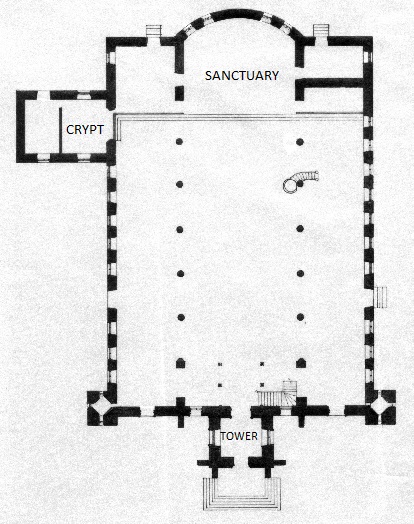
The Roseau Cathedral building is full of surprises and hidden secrets.
You will appreciate that a whole lot of research is going in these articles on the Roseau Cathedral. This present article is very special to me as I made a real discovery.
Years ago I purchased some books on the beautiful Gothic Cathedral of Chartres, which I wanted to visit in 2006. One of them titled “Chartres: Sacred Geometry, Sacred Space” written by Gordon Strachan, who taught in the department of Architecture and also Religious Studies at the University of Edinburgh.
The MANDORLA, as an architectural shape to set out a Catholic Cathedral floor plan, was revealed to me in this book. This is very old Christian symbolism, which I am about to reveal to you in our Roseau Cathedral. 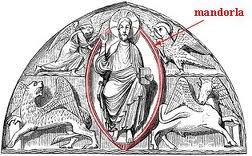
“Symbols of the Christian Faith” describe the mandorla as an almond-shaped aureole or halo that symbolizes the glory surrounding the figures of the Virgin Mary, the Trinity, and Christ in Majesty. The mandorla was especially used in icons and depictions of the Transfiguration of the Lord and the Assumption of Mary.
The 1531 Tilma of Juan Diego, showing to this day Our Lady of Guadalupe, is surrounded by the rays of the sun in the shape of a mandorla. 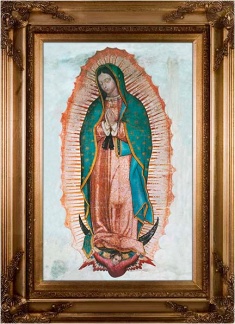
The MANDORLA is an unique Christian symbol, being the intersection between two circles whose circumferences passed through each other’s centres.
It became known as the VESICA PISCIS, the womb of the fish, Christianity’s main symbol during the early church period. The cross or crucifix was only adopted after 313AD ,with Roman emperor Constantine’s acceptance and legalisation of Christianity.
The fish , ICHTHUS or ΙΧΘΥΣ in Greek, being Jesus Christ, God, Son, Saviour
C hristos = Christ
T heou = God
U ios = son
S oter = Saviour
The Oneness of God could only be architecturally expressed as a CUBE. “the perfection of Oneness because it has the ration of 1:1:1.”
The diagonal of a cube with the side length as1 is the square root of three : √3. This proportion 1 over √3 , as derived of the cube (God is One) and the Vesica Piscis provide us with the width and length of the mandorla shape as used in Christian imagery and also in sacred geometry on the floor plan of Chartres Cathedral in France.
My curiosity was awakened. Would the same 1 over √3 sacred geometry called “ad triangulum” have been used in our Roseau Cathedral ? This Roseau church building that has been started, stopped, changed, built, stopped, completed, expanded and finally completed to what it is now, over so many years as we will see in a subsequent article.
And INDEED SO IT WAS!
As we have at our disposal a recent electronic surveyed Roseau Cathedral floor plan “AS IS” on AutoCAD, which was used to design the new roof, we have now accurate measurements and distances between walls and columns. The results of my research have been verified by architect Mr. Bergis STOUTE and can be verified by any architect, as is presented below.
In medieval art Jesus was often depicted above the Cathedral entrance doors, seated in Majesty in the Vesica Pisces, mediating between the two circles symbolising God and man.
In our Cathedral, dedicated to THE VIRGIN MARY (the womb of the FISH) and with Her Assumption as Parish feast, the architecture has all the more meaning.
But the image below will make the meaning more visual and meaningful. An image is a portal to a deep spiritual meaning ! See the Mandorla of “MARY and CHRIST sitting IN MAJESTY” transposed on the sacred geometry of the Roseau Cathedral.
Since the beginning of time, mankind has used a beautiful language to reveal the deeper mysteries and higher aspirations of life. This language is called the language of the sign and symbol.
In his apostolic exhortation “Sacramentum Caritatis”, Pope Benedict XVI pleads for catechesis or instructions concerned with the meaning of signs : “ This is particularly important in a highly technological age like our own, which risks losing the ability to appreciate signs and symbols” end quote.
It is in this act of my sharing the signs and symbols with you (“ treasures and hidden secrets”) of our Roseau Cathedral that I hope you will come to appreciate the spiritual meaning behind the objects and building .
THE HISTORY OF THE ST. ANN’s CHURCH IN COULIBISTRIE
The history of the St. Ann’s church in Coulibistrie
Part 1 by Bernard Lauwyck
 Coulibistrie had a wooden chapel covered with trash before 1892, which was blessed on July 27,1862 by Bishop R.C.M. Poirier, 3rd Bishop of Roseau (1858 – 1878) .
Coulibistrie had a wooden chapel covered with trash before 1892, which was blessed on July 27,1862 by Bishop R.C.M. Poirier, 3rd Bishop of Roseau (1858 – 1878) .
St. Ann , the mother of Mary and the powerful patroness of French Brittany was introduced by the Congregation of Jesus and Mary (the Eudist Order) who came to Dominica, after their fellow Eudist , Bishop Poirier, invited them.
Coulibistrie used to be part of the St. Joseph Parish, but became attached to the St. Peter’s Parish by Bishop Poirier’s Episcopal Degree of August 16, 1866.
At that time, Fr. Peter Lehaire, an Eudist Father was parish priest and devoted his time between Colihaut, Dublanc and Coulibistrie.
When Fr. Camil Marchal was appointed parish priest of the parish of St. Peter in January 1874 he found both church and presbytery in Colihaut in excellent condition, so “he turned his attention to Coulibistrie, where he built a presbytery, the first that ever existed in that locality. Up to that time the parish priest had to go by rowboat to Coulibistrie on certain Sunday mornings, sing High Mass and Vespers, and return the same day to Colihaut. In future he was able to remain from Sunday till Monday, or even to reside there as long as he deemed it necessary for the needs of the district.” (EBR)
Upon Fr. Camil Marchal’s death on Nov. 12 1876, Fr. Jules François Michel, former parish priest of St. Mark’s in Soufriere, was appointed forthwith as his successor.
It was during the long ministry of Fr. Michel that the present stone church in Coulibistrie was built. This church was built of natural stone, which can be found in the nearby river and beach. It has a rectangular shape with a length of 59 feet and is 32 feet wide, The apse is half -circular. Four stone buttresses were placed at the corners.
This church was solemnly blessed by Bishop Michael Naughten , 4th Bishop of Roseau (1880- 1900) on August 24, 1892.
When Fr. Jules Michel died on March 14, 1901 he was buried in the church in Coulibistrie. A memorial plaque in the church commemorate him. Fr Jules François Michel was a French priest, who was ordained in 1865 in the Roseau Cathedral, became parish priest of St. Peter in 1876.
According to THE ECCLESIASTICAL BULLETIN OF ROSEAU (EBR 1924) he was a very energetic priest and a strict disciplinarian with a temper.
In 1904 the FMI fathers took over the parish and Fr. Theodore Gerbier FMI constructed a brand –new presbytery at Coulibistrie described as “the lower storey of which is in stone and the upper storey, with a fine gallery all round, in wood ” (EBR).
I found no reports of damage to this church during the 1916 hurricane, which caused so much devastation in Colihaut, nor the 1928 and 1930 hurricanes.
Fr. Jean Guéry FMI ( + ) was the parish priest in Colihaut at the time of the devastation caused by hurricane David on Aug 29 1979. He contacted his confreres in Guadeloupe and the church roof in Coulibistrie was replaced in the shortest possible time.
In 2004 new beautiful stained glass windows were installed by Fr. Elveau Augustine. A new concrete choirloft and ceramic floor tiles, covering the old flat stone floor, were added also.
